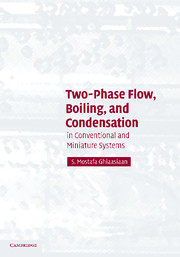Book contents
- Frontmatter
- Contents
- Preface
- Frequently Used Notation
- TWO-PHASE FLOW, BOILING AND CONDENSATION IN CONVENTIONAL AND MINIATURE SYSTEMS
- PART ONE TWO-PHASE FLOW
- PART TWO BOILING AND CONDENSATION
- 11 Pool Boiling
- 12 Flow Boiling
- 13 Critical Heat Flux and Post-CHF Heat Transfer in Flow Boiling
- 14 Flow Boiling and CHF in Small Passages
- 15 Fundamentals of Condensation
- 16 Internal-Flow Condensation and Condensation on Liquid Jets and Droplets
- 17 Choking in Two-Phase Flow
- APPENDIX A Thermodynamic Properties of Saturated Water and Steam
- APPENDIX B Transport Properties of Saturated Water and Steam
- APPENDIX C Thermodynamic Properties of Saturated Liquid and Vapor for Selected Refrigerants
- APPENDIX D Properties of Selected Ideal Gases at 1 Atmosphere
- APPENDIX E Binary Diffusion Coefficients of Selected Gases in Air at 1 Atmosphere
- APPENDIX F Henry's Constant of Dilute Aqueous Solutions of Selected Substances at Moderate Pressures
- APPENDIX G Diffusion Coefficients of Selected Substances in Water at Infinite Dilution at 25°C
- APPENDIX H Lennard–Jones Potential Model Constants for Selected Molecules
- APPENDIX I Collision Integrates for the Lennard–Jones Potential Model
- APPENDIX J Physical Constants
- APPENDIX K Unit Conversions
- References
- Index
14 - Flow Boiling and CHF in Small Passages
- Frontmatter
- Contents
- Preface
- Frequently Used Notation
- TWO-PHASE FLOW, BOILING AND CONDENSATION IN CONVENTIONAL AND MINIATURE SYSTEMS
- PART ONE TWO-PHASE FLOW
- PART TWO BOILING AND CONDENSATION
- 11 Pool Boiling
- 12 Flow Boiling
- 13 Critical Heat Flux and Post-CHF Heat Transfer in Flow Boiling
- 14 Flow Boiling and CHF in Small Passages
- 15 Fundamentals of Condensation
- 16 Internal-Flow Condensation and Condensation on Liquid Jets and Droplets
- 17 Choking in Two-Phase Flow
- APPENDIX A Thermodynamic Properties of Saturated Water and Steam
- APPENDIX B Transport Properties of Saturated Water and Steam
- APPENDIX C Thermodynamic Properties of Saturated Liquid and Vapor for Selected Refrigerants
- APPENDIX D Properties of Selected Ideal Gases at 1 Atmosphere
- APPENDIX E Binary Diffusion Coefficients of Selected Gases in Air at 1 Atmosphere
- APPENDIX F Henry's Constant of Dilute Aqueous Solutions of Selected Substances at Moderate Pressures
- APPENDIX G Diffusion Coefficients of Selected Substances in Water at Infinite Dilution at 25°C
- APPENDIX H Lennard–Jones Potential Model Constants for Selected Molecules
- APPENDIX I Collision Integrates for the Lennard–Jones Potential Model
- APPENDIX J Physical Constants
- APPENDIX K Unit Conversions
- References
- Index
Summary
Minichannel- and Microchannel-Based Cooling Systems
Compact heat exchanges, refrigeration systems, the cooling systems for microelectonic devices, and the cooling systems for the first wall of fusion reactors are some examples for the applications of minichannel- and microchannel-based cooling systems. Compact heat exchanges and refrigeration systems in fact represent an important current application of minichannels. Figure 14.1 displays typical minichannel flow passages in compact heat exchanges. In this chapter, flow boiling and CHF in channels with 10 μm ≲ DH ≲ 3 are discussed.
Distinction should be made between minichannel- and microchannel-based systems because they are different for several phenomenological and practical reasons. Some important differences between the two channel size categories with respect to the basic two-phase flow phenomena, in particular the flow patterns and the gas–liquid velocity slip, were discussed in Section 3.7 and Chapter 10. Other important differences between the two categories are as follows:
For practical reasons microchannel cooling systems are typically designed as arrays of parallel channels connected at both ends to common inlet and outlet plena, manifolds, or headers. Multiple parallel channels with common inlet and outlet mixing volumes are susceptible to instability, flow maldistribution, and oscillations. Minichannel cooling systems, in contrast, are designed both as parallel arrays as well as individual channels with independent flow controls.
Also for practical reasons, microchannels operate under low-flow conditions. Minichannel systems can operate over a wide range of coolant flow rates, however.
[…]
- Type
- Chapter
- Information
- Two-Phase Flow, Boiling, and CondensationIn Conventional and Miniature Systems, pp. 405 - 435Publisher: Cambridge University PressPrint publication year: 2007



